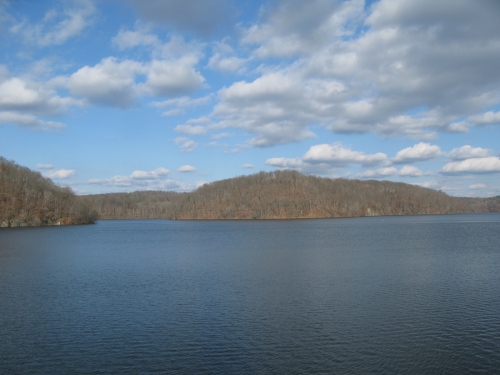 The city’s tendrils reach deep into the countryside, but so too do its arteries. When Croton water arrived in New York City in 1842, there was much rejoicing. What was already the largest city in the country hadn’t had a reliable water supply before this, dependent as it was on often contaminated wells. The lack of ample water meant that fires, back when many buildings were still wood, were a huge threat; equally if not more threatening were the epidemics caused by water-bourn diseases (cholera struck in 1832 and 1834). The blessed water was transported more than 40 miles from upstate through a great civil engineering project, one of the 19th century’s largest. Fed by a dammed reservoir, a masonry aqueduct, not so different from the ancient Roman ones, dropped down through Westchester and Bronx counties and over the High Bridge to the receiving reservoir in what later became Central Park and then into the distributing reservoir at what later became the NYPL and Bryant Park (of suitably, marvelously, pharonic design). The Old Croton Aqueduct no longer brings water to NYC*, (the northern part is still used to supply Ossining) but its route is now a park, probably the narrowest one north of the High Line.
The city’s tendrils reach deep into the countryside, but so too do its arteries. When Croton water arrived in New York City in 1842, there was much rejoicing. What was already the largest city in the country hadn’t had a reliable water supply before this, dependent as it was on often contaminated wells. The lack of ample water meant that fires, back when many buildings were still wood, were a huge threat; equally if not more threatening were the epidemics caused by water-bourn diseases (cholera struck in 1832 and 1834). The blessed water was transported more than 40 miles from upstate through a great civil engineering project, one of the 19th century’s largest. Fed by a dammed reservoir, a masonry aqueduct, not so different from the ancient Roman ones, dropped down through Westchester and Bronx counties and over the High Bridge to the receiving reservoir in what later became Central Park and then into the distributing reservoir at what later became the NYPL and Bryant Park (of suitably, marvelously, pharonic design). The Old Croton Aqueduct no longer brings water to NYC*, (the northern part is still used to supply Ossining) but its route is now a park, probably the narrowest one north of the High Line.
I attempt to live at all costs without a car. The OCA trail was made for me and my kind, since it is easily accessible for most of its route through Westchester via the MetroNorth and within NYC through “transporte coletivo” as the Portuguese has it (at least on the MTA map). We took MetroNorth to Croton-Harmon, the farthest stop from the trail, but also the closet to the trail’s beginning. We wanted to follow the direction of the old water down, but you could start at 42nd Street and make your way north. To get to the start, we walked through the Croton Gorge, a lovely spot unknown to me before this, where the Croton cuts through a steep wooded valley. This portion of our walk was filled with mushrooms.  These tall thin trees tell a tale of an area that was once logged out, like virtually all of the region.
These tall thin trees tell a tale of an area that was once logged out, like virtually all of the region.  The OCA starts at the New Croton Dam, a rather fine piece of masonry, completed in 1906, whose history is full of specially imported Italian stonemasons and a strike that won these workers a 8-hour day.
The OCA starts at the New Croton Dam, a rather fine piece of masonry, completed in 1906, whose history is full of specially imported Italian stonemasons and a strike that won these workers a 8-hour day. 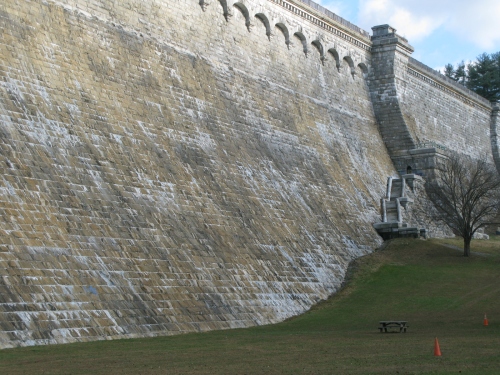 This was the highest dam in the world in its day. Its reservoir drowned the Old Croton Dam and reservoir system, as well as the initial portion of the aqueduct. There was a juvenile Bald Eagle circling over the reservoir, as well as a smaller raptor (well, they all are in comparison) they flew off as we followed the eagle; a Kingfisher raced across the reservoir, which covers old farms and mills and cemeteries (1500 bodies were moved).
This was the highest dam in the world in its day. Its reservoir drowned the Old Croton Dam and reservoir system, as well as the initial portion of the aqueduct. There was a juvenile Bald Eagle circling over the reservoir, as well as a smaller raptor (well, they all are in comparison) they flew off as we followed the eagle; a Kingfisher raced across the reservoir, which covers old farms and mills and cemeteries (1500 bodies were moved). 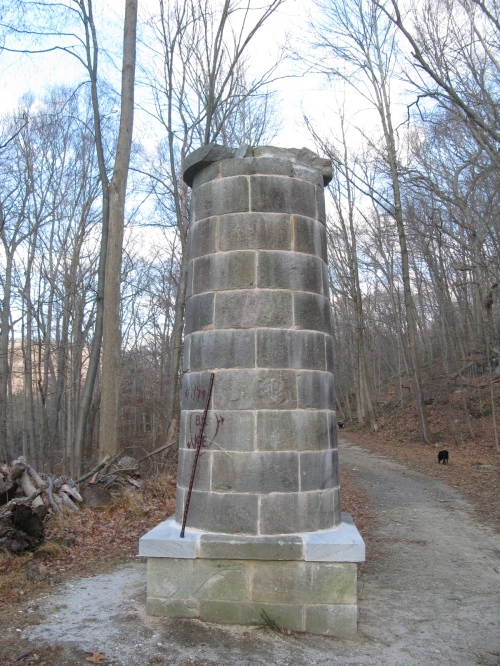 Roughly every mile of the OCA has a ventilation tower (my four foot blackthorn for scale).
Roughly every mile of the OCA has a ventilation tower (my four foot blackthorn for scale). 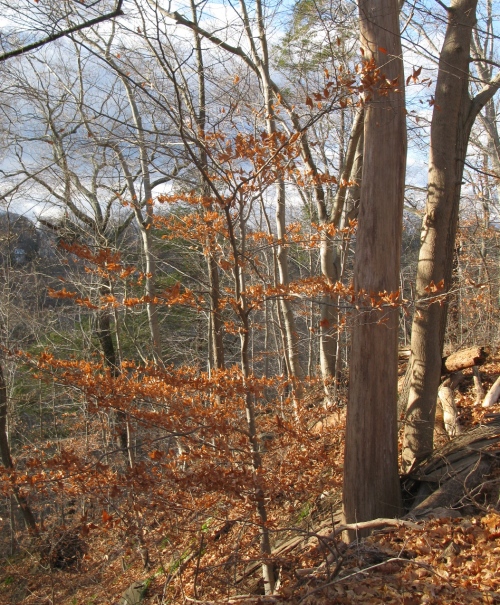 The route was first full of beech trees, some still leaved, the silver bark and golden tan leaves lit up with late afternoon sun to a fairly high level of fall gorgeousness. Then it was literally littered with black walnuts, a bumper crop evidently, all darkening and softening (at least the outer fleshy parts). The trail goes past many a backyard, our day’s portion providing a few too many MacMansions.
The route was first full of beech trees, some still leaved, the silver bark and golden tan leaves lit up with late afternoon sun to a fairly high level of fall gorgeousness. Then it was literally littered with black walnuts, a bumper crop evidently, all darkening and softening (at least the outer fleshy parts). The trail goes past many a backyard, our day’s portion providing a few too many MacMansions. 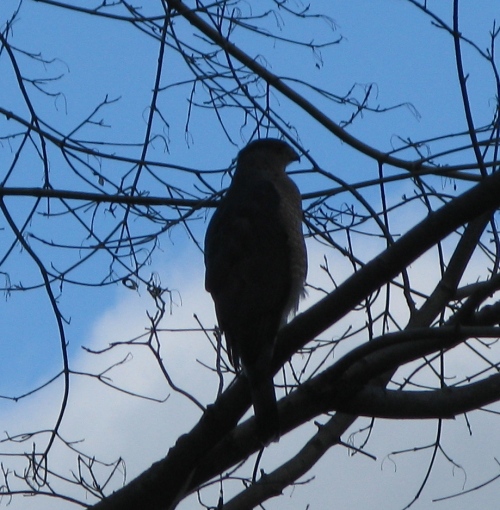 This Cooper’s Hawk was probably keeping an eye on the local bird-feeders. A Pileated Woodpecker’s loud call made us turn around in time to see the flying dinosaur land high up in a tree. Another juvenile Baldie was seen high over the “Crossing,” a bicycle path that parallels Route 9 over the mouth of the Croton River and runs by some of the tallest Pragmites I’ve ever seen (we used this to return to the Croton Harmon station).
This Cooper’s Hawk was probably keeping an eye on the local bird-feeders. A Pileated Woodpecker’s loud call made us turn around in time to see the flying dinosaur land high up in a tree. Another juvenile Baldie was seen high over the “Crossing,” a bicycle path that parallels Route 9 over the mouth of the Croton River and runs by some of the tallest Pragmites I’ve ever seen (we used this to return to the Croton Harmon station).
The Friends of the OCA produce two maps of the trail, one for the marathon 26.2 miles of it in Westchester and one for the rest as it goes through NYC. These are essential. The trail is pretty obvious once you’re on it, but there are few markers, and there are places where you’re forced to get off it (for instance, you have to circle a large GE campus where they “put good things to death” as their jingle should have it) and use local roads to get back onto it. We will eventually do the entire course of the trail.
*Three aqueducts distribute 1.3 billion gallons of water a day into the city: the New Croton (east of the original, connected to a much-expanded Croton System that is still the smallest of these three), the Catskill (with its 1,100 foot deep tunnel under deepest part of the Hudson), and the Delaware (which holds the record for the world’s longest continuous underground tunnel, 85 miles).
It’s fashionable to say city dwellers are divorced from nature. Only in their own minds. In actuality they are still very much married. In this case, to distant watersheds and a hydrological cycle that their lifestyles, not to say lives, are predicated on. Put that in your coffee cup (which is probably made of that very fine mud we call clay) and drink it.
Leave a comment